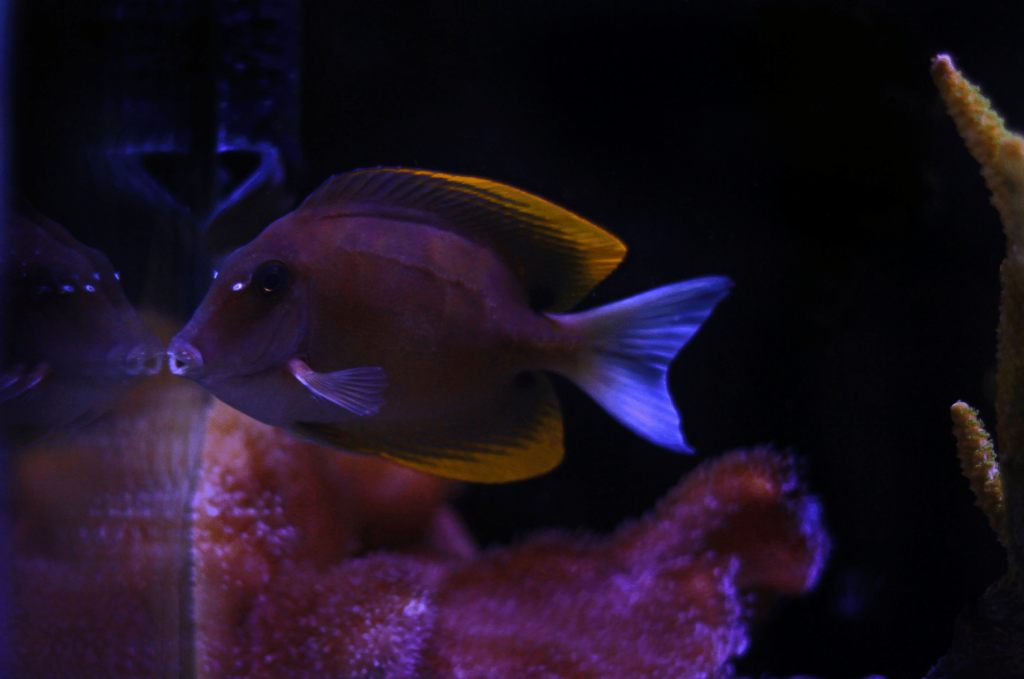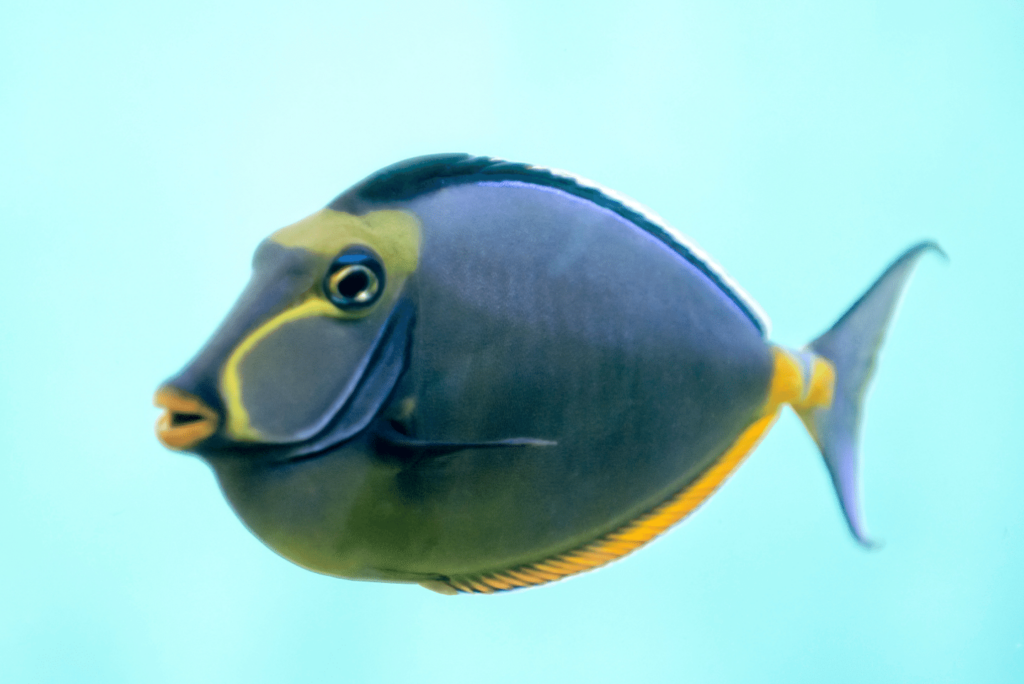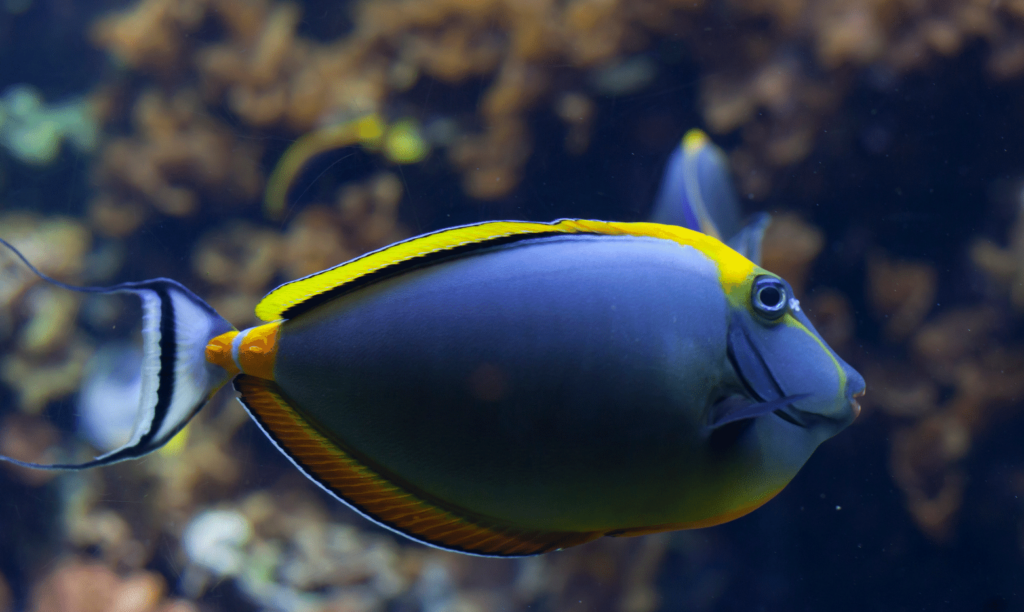Your cart is currently empty!

Gold Rim Tang: Common Challenges and How to Overcome Them
The Gold Rim Tang fish, also known as the Whitecheek Surgeonfish (Acanthurus nigricans), is a captivating marine species admired for its striking appearance and vibrant colors. However, keeping these beautiful fish in a home aquarium can be challenging because of their specific care requirements.
In this post, we will explore the common challenges of keeping Gold Rim Tang fish and provide practical solutions to overcome them.
Gold Rim Tang: The Jewel of the Reef
The Gold Rim Tang, also known as the Gold-rimmed Surgeonfish or Powder Brown Tang (scientific name: Acanthurus nigricans), is a marine fish commonly found in coral reefs in the Indo-Pacific region. Here are some key characteristics:
Appearance
- Color: Typically, they have a dark brown to black body with a distinctive white or yellowish stripe along the rim of the dorsal fin and around the gill area.
- Size: They can grow to about 8 inches (20 cm) in length.
- Shape: The body is oval and laterally compressed, typical of tangs and surgeonfish.
Common Challenges in Keeping Gold Rim Tang

Keeping Gold Rim Tang fish presents several challenges:
- Water Quality Sensitivity: Gold Rim Tang fish are highly sensitive to fluctuations in water quality and require consistent and pristine conditions.
- Tank Size Requirements: They need ample space for swimming, with a minimum tank size of 100 gallons, making them unsuitable for smaller aquariums.
- Dietary Needs: These fish require a varied diet rich in marine algae and vegetables, and they can be picky eaters, complicating dietary management.
- Aggressive Behavior: Gold Rim Tang fish can exhibit aggression towards other tangs or similarly shaped fish, challenging tank mate compatibility.
- Health Vulnerability: They are prone to diseases such as ich and marine velvet, and their sensitive immune systems make them more susceptible to infections.
- Acclimation Difficulties: Acclimating them to a new environment can be challenging, as stress from shipping and handling can weaken their immune systems.
- Stress-Related Behaviors: When stressed, they may hide, show reduced activity, or lose their appetite, indicating difficulties in adjusting to their environment.
- Habitat and Lighting Needs: They require specific lighting and a habitat that mimics their natural environment to thrive, adding complexity to their care.

How to Overcome These Challenges
Ensuring Adequate Tank Size
To address the space challenge, it is essential to invest in a tank that meets the minimum size requirement of 125 gallons. When setting up the tank, ensure plenty of open swimming space and consider adding live rock formations to provide hiding spots and territories. Regularly check the tank’s layout to ensure it remains suitable for the fish’s growing size and activity levels.
Maintaining Water Quality
Maintaining pristine water quality requires regular monitoring and testing of water parameters. Invest in high-quality test kits to check ammonia, nitrite, nitrate, pH, and specific gravity levels. Implement effective filtration systems and perform regular water changes (10-20% weekly) to keep the water clean. Consider using protein skimmers and activated carbon to help maintain water quality.
Providing a Balanced Diet
To meet the dietary needs of Gold Rim Tang fish, provide a varied diet that includes marine algae, nori (dried seaweed), and high-quality herbivore pellets. Supplement their diet with fresh vegetables like spinach and lettuce. Feed small amounts several times daily to mimic their natural grazing behavior and prevent overfeeding, which can pollute the water.
Ensuring Compatibility
When selecting tank mates for Gold Rim Tang fish, choose peaceful species that occupy different areas of the tank. Avoid adding other tangs or fish with similar body shapes to minimize aggression. Introduce new fish gradually and observe their interactions closely to manage any potential conflicts.
Preventing and Treating Diseases
Preventive measures are crucial for reducing the risk of disease. Quarantine new fish before adding them to the main tank to avoid introducing pathogens. Maintain optimal water quality and reduce stress by providing a stable environment. If disease symptoms appear, such as white spots or fin damage, promptly treat the fish with appropriate medications. Consult a veterinarian or aquatic specialist for guidance on specific treatments.
Expert Tips and Best Practices
- Regular Monitoring and Maintenance: Routine checks and maintenance tasks are essential for stabilizing the tank environment. Perform weekly water tests, regularly clean the tank and equipment, and monitor the fish for signs of stress or illness. Keeping a maintenance schedule can help ensure that all necessary tasks are completed on time.
- Stress Reduction Techniques: Minimize stress for Gold Rim Tang fish by creating a calm and secure tank environment. Provide plenty of hiding spots and avoid sudden changes in lighting or water parameters. Handle the fish gently during tank maintenance to prevent injury and stress.
- Seeking Professional Help: If you encounter persistent problems or health issues with your Gold Rim Tang fish, do not hesitate to seek professional help. Consult a veterinarian who specializes in aquatic animals or join online forums and communities for advice from experienced aquarists. Accessing expert knowledge can help you address challenges more effectively.

Looking for a Unique Experience? Visit Diamonds by Raymond Lee’s Boca Aquarium!
Caring for Gold Rim Tang fish requires dedication and attention to detail. By understanding and addressing common challenges such as tank size, water quality, diet, compatibility, and disease prevention, you can create a healthy and thriving environment for these stunning marine fish.
Remember to monitor your tank regularly, provide a balanced diet, and seek professional help when needed to ensure the well-being of your Gold Rim Tang fish.
If you want to explore where luxury shopping meets marine wonder, Diamonds by Raymond Lee’s Aquarium in Boca Raton is the place to be. Our stunning marine exhibits and educational programs offer a unique and enriching visit.
Whether you’re admiring the beauty of our aquatic life or learning about marine conservation, each visit provides a fresh and memorable experience. Consider hosting your next event with us, surrounded by the serene beauty of the underwater world. Dive into a world of wonder today!
